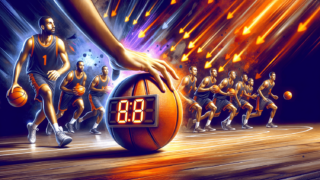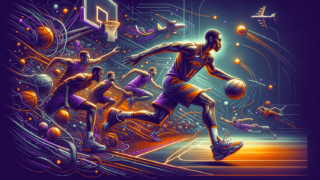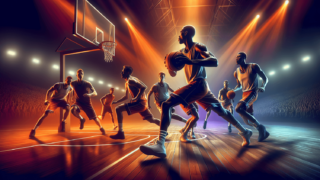
Double Dribble: What’s It and When Does It Happen?
Written by: Basketball Universe
Last updated:

Welcome to another thrilling edition of hoops talk! In today’s post, we’ll unravel the mysteries behind the notorious ‘Double Dribble’ – one of the most common and sometimes most puzzling violations in the game of basketball. Put on your sneakers, grab a ball, and let’s dive into the nitty-gritty of this fascinating rule that affects everyone from rookie ballers to NBA pros. Whether you’re a novice or an experienced player, understanding the mechanics and nuances of the double dribble will make you a smarter, more strategic player on the court.
Double Dribble: What’s It and When Does It Happen?
A double dribble is a basketball violation that occurs when a player dribbles the ball with two hands simultaneously, or stops dribbling and then starts again without passing or shooting the ball. This results in an immediate turnover, giving the opposing team possession of the ball.
Unpacking the Double Dribble Rule: Who’s Affected?
From peewee leagues to the NBA, double dribbling is a universal violation that all players must be mindful of, rendering the need to understand its ins and outs crucial. In this journey of exploring double dribbling, we’ll shed light on its history, technicalities, and intent, while examining some famous examples showcasing the violation. So, grab a courtside seat and watch how learning the fundamentals of basketball rules can take your gameplay to new heights!
History and Intent: How Did Double Dribble Come to Be?
The double dribble rule was introduced to create a level playing field and ensure fluid ball movement on the court. While early basketball games had no dribbling, players soon discovered that bouncing the ball made it easier to avoid defenders. However, unregulated dribbling allowed players to take advantage of the rules and unfairly steal the show. Thus, the prohibition of double dribbling came into play, becoming a staple of basketball’s ever-evolving rulebook.
The Aim of the Rule: Improving Gameplay
By implementing the double dribble rule, the game of basketball achieved enhanced structure and increased the importance of skillful ball handling. As a result, it compelled players to improve their dribbling skills, develop passing techniques, and strategize their movements. The rule also promoted teamwork, as players had to pass or shoot once they picked up their dribble, requiring coordinated offensive plays and utmost cooperation.
Analyzing the Double Dribble Rule: Tremendous Technicalities
Now that we’ve explored the intent and impact of the double dribble rule, let’s dive into its technical aspects, breaking down scenarios that warrant a violation call.
Two-handed Dribbling: A No-go Zone
One of the key elements of a double dribble occurs when a player dribbles the ball with two hands simultaneously. Not only does this give the dribbler an unfair advantage, but it hinders fluid gameplay. To avoid this violation, players must handle the ball with one hand at a time, allowing the other hand to maintain distance from the ball during the dribble motion.
Restarting the Dribble: Pressing the Reset Button
The second component of the double dribble violation arises when a player stops dribbling and then restarts without either passing or shooting the ball. This scenario often materializes when a player picks up the dribble, takes a few steps, and recommences dribbling. It’s crucial for players to remember to only execute one continuous dribble to avoid being penalized.
Double Dribble in Real-Life Situations: Learning from the Pros
While double dribbling can occur at any level of the game, analyzing instances documented in professional games can help players better recognize and avoid such violations. Let’s take a look at two memorable NBA examples that shook up gameplay and showcased the severity of making a simple mistake.
The Notorious LeBron James Double Dribble
LeBron James, a widely renowned basketball superstar, isn’t immune to making errors. During a 2019 game between the Los Angeles Lakers and Denver Nuggets, LeBron committed a double dribble that went uncalled. After an offensive rebound, he picked up his dribble and began walking down the court, then restarted his dribble. Luckily for LeBron, the referees missed the violation, but the incident served as a reminder that even top-tier professionals can slip up.
Carmelo Anthony’s Double Dribble Debacle
Another noteworthy example hails from a 2013 game between the New York Knicks and Indiana Pacers. Carmelo Anthony, then playing for the Knicks, experienced a critical lapse in concentration during the closing minutes of a tight game. Sadly, the referees didn’t miss his mistake; they called the double dribble, and his team lost possession of the ball, impacting the game’s outcome. This situation underscores how vital it is to maintain focus and discipline throughout the game – every possession matters!
Common Misconceptions: Debunking Double Dribble Myths
When discussing basketball rules, it’s common for misconceptions to arise. Double dribbling is no exception. Let’s clarify and debunk some common myths surrounding this violation, ensuring your understanding is nothing but net.
Fumbles and Loose Balls: What’s the Verdict?
One of the most rampant double dribble myths suggests that players who fumble or lose control of the ball and regain possession cannot continue dribbling. However, the rulebook indicates that, provided the player never willingly ended the initial dribble, they can continue to dribble after recovering a fumbled or loose ball. So, fret not about losing control – it happens to the best of us!
Double Dribbling and Shot Fakes
Another misconception is that shot fakes automatically lead to a double dribble violation. In reality, the rule states that players can execute a shot or pass fake, and if their feet remain firmly planted, they can continue dribbling. The key takeaway here is that careful footwork can lead to a successful fake-out without committing a rule violation – so step smart and play on!
Double Dribble and You: Minimizing Missteps in Your Game
While the concept of double dribbling might now be crystal clear, applying this newfound knowledge during gameplay is an entirely different ball game. With these tips, you can reduce the chances of committing double dribble violations and become a smooth ball-handling machine.
Mastering the Fundamentals: Ball Control and Dribble Skills
Drilling the basics is crucial to avoiding double dribbles. Focus on refining your single-hand dribbling capabilities, practicing various speeds, heights, and directions. Consider trying timed dribble exercises to simulate in-game pressure, and remember – repetition is your friend!
Practicing Decision-Making: Pass vs. Shoot
Honing decision-making skills is pivotal in preventing double dribbles. Be mindful of your offensive intent, whether it’s a pass or a shot, and firmly commit to that decision. Hesitation can result in a violation, so think fast and stay sharp!
Game Film Study: Watching and Learning
Another useful tool for preventing double dribbles involves analyzing professional games. Observing skilled players helps you internalize proper techniques and understand effective ball handling patterns. The more you study, the better equipped you’ll be on the court – knowledge is power!
Avoiding Double Dribble Violations: The Ticket to Basketball Success
As you gather your equipment and hit the court, remember that understanding the double dribble rule – its history, purpose, technicalities, and applications – can vastly improve your basketball IQ. Missteps are inevitable, but by embracing basketball rules, refining your skills, and viewing gameplay through the lens of discipline and focus, you’ll ultimately elevate the quality of your performance, making you a formidable force on the court.
Drills and Exercises to Enhance Ball Handling
Let’s explore some drills and exercises that can help you avoid the dreaded double dribble while bolstering your ball-handling prowess. These activities will fine-tune your dribbling skills, build muscle memory, and ultimately strengthen your overall basketball performance.
Figure-Eight Dribble Drill
This agility-oriented exercise focuses on enhancing dribble control around your body. With legs shoulder-width apart, start dribbling the ball with one hand at a slightly bent position. Move the ball through your legs in a figure-eight pattern, alternating between your left and right hands. Gradually increase your speed and maintain a good rhythm as you become comfortable with the motion.
Two-Ball Dribble Drill
The two-ball dribble drill is designed to elevate your ball-handling coordination and confidence. Begin by dribbling two balls simultaneously but asynchronously, meaning one ball bounces as the other leaves your hand. Start slowly and build up the pace, maintaining control over both balls. Eventually, try alternating between the balls bouncing together and asynchronously for added complexity.
Wall Dribble Drill
This exercise, while simple, can greatly impact your dribbling power and control. Using a wall for support, dribble the ball against it, progressively increasing force and speed. Switch hands and repeat the exercise. This drill strengthens your wrists and forearms, ultimately improving your dribbling stability.
Developing Basketball IQ to Avoid Double Dribbling
An essential aspect of avoiding double dribbling – and indeed, excelling in basketball – is cultivating a high basketball IQ. Possessing game awareness, understanding your role, and recognizing your teammates’ intentions will enable you to make the most informed choices on the court.
Learn from the Masters: Coach Input and Mentorship
Coaches and mentors with extensive basketball knowledge can help you build a solid foundation for understanding the game. Embrace their insights, ask questions, and actively apply their guidance during your training sessions and games. Remember that continuous learning and growth separate good players from great ones.
Expand Your Mind: Explore Books and Articles
Diversify your learning resources by delving into basketball-related books, articles, podcasts, and even instructional videos. The more information you consume, the better equipped you’ll be to recognize patterns and make decisions that steer clear of double dribbling and other unwelcome violations.
Teamwork Makes the Dream Work: Communication and Synergy
Developing chemistry with teammates is paramount for well-executed gameplay. Through effective communication, players can support each other, provide essential feedback, and work collectively to avoid double dribbling and prevent other rule violations.
As you absorb the nuances of the double dribble rule and the methods to avoid it, remember to stay persistent in your training and apply your newfound knowledge during play. With diligence, focus, and an ever-growing basketball IQ, you’ll set yourself on a path to basketball success.
Frequently Asked Questions: Double Dribble Edition
As you further develop your understanding of double dribbling and its impact on the game, you might have some lingering questions on the topic. This FAQ section addresses some common inquiries related to double dribbling, providing succinct answers to enrich your basketball knowledge.
1. Can players regain possession after stopping their dribble?
Yes, players can regain possession after stopping their dribble; however, they cannot resume dribbling. Instead, they must either shoot or pass the ball to avoid committing a double dribble violation.
2. What’s the penalty for double dribbling?
If a double dribble violation is committed, the opposing team gains possession of the ball from a sideline out-of-bounds throw-in.
3. Is a double dribble called only when touching the ball with both hands?
No, a double dribble can be called for either dribbling with both hands simultaneously or stopping the dribble and then restarting without passing or shooting the ball.
4. Can a player dribble after catching his airball?
No, if a player shoots, the ball must make contact with the rim, backboard, or another player before they can resume dribbling. Dribbling after catching an airball would result in a double dribble violation.
5. How does double dribble differ from traveling?
Double dribble refers to either two-handed dribbling or resuming dribbling after stopping. Traveling occurs when a player with possession of the ball takes too many steps without dribbling or establishes a pivot foot and lifts it without releasing the ball.
6. Can losing control of the ball reset the dribble?
If a player has genuinely lost control of the ball, they can regain possession and continue dribbling without being called for a double dribble.
7. Are there situations where players can use both hands while dribbling?
No, using both hands to dribble simultaneously is a clear violation of double dribble rules. Players must dribble using one hand at a time.
8. Can a player pivot after stopping their dribble?
Yes, a player can pivot after stopping their dribble, provided that they maintain their pivot foot in place on the ground. If they lift the pivot foot, it would result in a traveling violation.
9. When should a player start dribbling after receiving a pass?
A player should begin dribbling immediately after catching a pass; otherwise, taking too many steps without dribbling could result in a traveling violation.
10. Can a player remain stationary and pick up the dribble multiple times?
No, once a player has picked up their dribble, they cannot resume dribbling without passing or shooting the ball. Doing so would result in a double dribble violation.
Featured Posts
- No pillar pages found.





